Puzzle-Based Clues
In an escape room in Manhattan, one of the most common types of clues players encounter are puzzle-based challenges. These puzzles can vary widely, ranging from simple riddles to complex mathematical equations. The goal is to encourage critical thinking and teamwork, as different players may contribute unique problem-solving skills. Puzzle-based clues often take the form of codes that must be deciphered, sequences that need to be arranged, or logic games that demand careful analysis.
For example, a group may stumble upon a locked chest that requires a combination to open. The digits for that combination might be hidden within a crossword puzzle or scattered throughout the room in fragmented pieces of information. Puzzle-based clues are especially popular in themed rooms like Hydeout or End of Days, where solving them contributes directly to the unfolding storyline. These challenges not only test intelligence but also creativity, as many require thinking outside the box to uncover hidden solutions.
Physical Interaction Clues
Another category of clues found in an escape room in Manhattan involves physical interaction. These are not simple mental puzzles but clues that require manipulating objects in the environment. A player may need to lift, move, or assemble different props to uncover hidden messages or compartments. For instance, turning a painting might reveal a hidden safe, or aligning certain objects in a precise order could unlock the next step in the game.
Physical interaction clues are designed to immerse participants more deeply into the storyline. They create a sense of realism, making players feel as though they are truly part of an unfolding mystery. In a game like Carbon: 3708, these physical clues often complement futuristic themes by integrating with mechanical devices or unusual props. Such clues encourage participants to stay observant and explore every corner of the room, making the experience highly engaging and dynamic.
Hidden Object Clues
Hidden object clues are classic elements in an escape room in Manhattan. These require players to search the environment thoroughly to find keys, symbols, or small notes hidden in unexpected places. The challenge is not only in spotting the object but in understanding its purpose within the overall game.
For instance, a small key might unlock a box that contains another puzzle, or a hidden piece of paper may provide essential instructions for decoding a cipher. Hidden object clues test a team’s attention to detail and persistence. Rooms like End of Days A and B often incorporate these to create a sense of urgency, pushing players to scour every inch of the space. Players must communicate effectively to ensure nothing is overlooked, as even the smallest item could be crucial for completing the game.
Word and Language Clues
Word-based or language clues are often present in escape room in Manhattan experiences. These challenges might include deciphering anagrams, interpreting foreign languages, or rearranging letters to reveal hidden words. Language-based puzzles add depth by connecting to the room’s narrative, often revealing backstories or guiding players toward the next step.
For example, a player might find a torn note with fragmented words that, when pieced together, form a coherent instruction. In another instance, a coded message could require translating into English to reveal a location in the room. These clues encourage not only individual intelligence but also group brainstorming, as players combine their language skills and creativity to solve the riddle. They are particularly engaging in mystery-themed rooms like Hydeout, where narrative immersion plays a central role.
Light and Sound Clues
Escape rooms often employ sensory elements such as light and sound to create unique clues. A flickering light might indicate the location of a hidden compartment, or a series of sounds could form a sequence that players must replicate on a keypad. These types of clues bring an immersive and atmospheric quality to the escape room in Manhattan.
Sound-based clues can include Morse code signals, rhythmic patterns, or recorded voices providing cryptic hints. Light-based clues, on the other hand, might involve ultraviolet flashlights revealing invisible ink messages or colored lights that must be matched to specific symbols. These sensory-based puzzles elevate the overall experience by engaging players on multiple levels and making them feel part of a high-stakes environment.
Combination Locks and Key Codes
Combination locks and key codes remain a staple in most escape room in Manhattan challenges. Players must gather pieces of information throughout the room to determine the correct sequence or code. This type of clue demands collaboration, as multiple team members may hold different fragments of the solution.
For example, a three-digit lock might require numbers found on separate props across the room, encouraging players to bring all the information together. The suspense of entering a code and waiting to see if the lock clicks open adds to the excitement. These locks are not only functional but also symbolic, representing milestones within the game. Each lock opened provides a sense of accomplishment and momentum, pushing the group further toward their final escape.
Symbol and Pattern Recognition Clues
Symbol and pattern recognition clues often test a player’s visual intelligence. These clues require players to identify recurring shapes, colors, or designs within the room. They are often embedded subtly into the décor, blending into the environment to create additional challenge.
For instance, a wallpaper pattern might conceal hidden numbers, or a set of symbols carved into props could represent directions for unlocking the next stage. Such puzzles are especially fitting in rooms with futuristic or apocalyptic themes like Carbon: 3708 or End of Days. Recognizing these patterns is not always straightforward and often requires teamwork, with one player spotting details that others may miss. These puzzles train participants to be observant and to challenge their assumptions.
Time-Based Clues
Some escape room in Manhattan challenges feature time-sensitive clues, adding an extra layer of pressure to the experience. These puzzles may require players to perform actions within a set period or solve problems under the pressure of a countdown.
For example, players might discover a sequence of lights that flash for only a few seconds, requiring them to quickly memorize and replicate the order. In another scenario, a door might automatically close if a solution is not completed in time, forcing the team to restart. Time-based clues add adrenaline and intensity, making the escape room experience more thrilling. They emphasize teamwork, as players must delegate tasks efficiently and maintain focus despite the mounting stress.
Narrative-Based Clues
Narrative-based clues are deeply tied to the storylines of each escape room in Manhattan. They typically involve uncovering backstories, reading character diaries, or interpreting events that have occurred within the fictional setting. These clues give context to the game and enhance immersion.
For example, in Hydeout, players may come across journals that provide vital background on a mysterious figure they are investigating. In End of Days, narrative-driven clues might involve deciphering notes left by survivors to piece together the sequence of events leading to the apocalypse. These clues enrich the storytelling aspect of escape rooms, making players feel like they are part of a living narrative where their choices and interpretations directly affect the outcome.
Conclusion
The types of clues commonly found in an escape room in Manhattan are diverse, ranging from puzzles and hidden objects to sound-based signals and narrative-driven hints. Each clue type challenges players in unique ways, ensuring the game is dynamic and engaging from start to finish. By incorporating puzzles, physical interaction, sensory elements, and strong storylines, escape rooms provide a memorable experience for all participants. Success depends on teamwork, observation, creativity, and quick thinking, making every game a unique adventure.
Frequently Asked Questions
Q: What types of clues are commonly found in an escape room in Manhattan?
A: Clues often include puzzles, hidden objects, word-based riddles, sensory hints like light or sound, and storyline-driven elements. These ensure a balanced mix of mental and physical challenges.
Q: Do all escape rooms use the same types of clues?
A: While many escape rooms share common elements such as combination locks or hidden objects, each game introduces unique clues that align with its specific theme and storyline.
Q: How difficult are the clues in an escape room in Manhattan?
A: Difficulty varies depending on the game. Some clues are straightforward, while others are more complex and require advanced problem-solving or teamwork to solve.
Q: Can beginners solve these clues without prior experience?
A: Yes, escape rooms are designed for all skill levels. Beginners can participate successfully, especially when working as a team, since clues vary in complexity to accommodate everyone.
Q: Are hints provided if we cannot solve a clue?
A: Yes, most escape rooms offer hints to help players progress. These are typically requested through a game master, ensuring participants remain engaged without getting stuck for too long.









